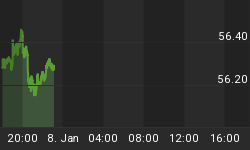Last week, speeches by Fed officials Kohn and Bernanke opened the door for more cuts either next week or in the near future. While 25 basis points is the most likely action based on how Fed Funds futures are trading, a 50 basis point cut is not far behind at about 36%. Friday's employment report could provide the pivotal data point. Perhaps providing a hint at what the Labor Department will report, the ADP report on Wednesday was much better than expected. According to the employment service firm, 189,000 jobs were added in November - more than triple the number economists forecasted. Currently, economists are forecasting that the Labor Department will report that 80,000 new jobs were created in November. This would be the smallest increase since June. There is evidence that the labor market is under more pressure than the nonfarm payrolls report has shown. The household survey has been a lot weaker than the establishment survey this year. The Household survey has averaged only 8,100 new jobs each month, whereas in 2006 it averaged 262,000. The establishment survey has reported an average of 125,400 jobs down from 188,600 last year.
Another sign that the economy has weakened was the drop in both ISM indexes. The manufacturing index dropped only 0.1 points, but its barely hovering over the 50 level at 50.8. The prices paid component had the largest increase. It jumped 4.5 points to 67.5, the highest level since June. Employment had one of the largest declines, down 4.2 to 47.8. This was the lowest since October 2003. The non-manufacturing index dropped 1.7 points to 54.1, the lowest level since March. Similar to the manufacturing index prices paid increased 13.0 points to 76.5. New orders and employment declined by 4.6 and one point respectively. The new order index fell to 51.1, the lowest since the Iraq War.
Several retailers have reported lackluster third quarter earnings along with tempering expectations for the fourth quarter. Last week, Sears Holding posted a loss of nice cents per share from operations. It was the first quarterly loss in four years. Operating margin fell by 200 basis points with was almost evenly split between lower gross margins (-97 basis points) and higher SG&A expense (+103 basis points). Kmart was the driving force behind the lower gross margins as the retailer had to discount seasonal items. Unfortunately, this didn't even help entirely since inventory still grew 4.5% while sales dropped 3.3%. Investors usually look for inventory growth to match sales growth.
This week, Chico's reported third quarter earnings of $0.11 per share, which was inline with analysts' estimates. But, the company said that "fourth quarter earnings could approach the break even level." Analysts were expecting around a nickel per share in earnings. Similar to Sears, Chico's gross margin was pressured, down 157 basis points, and still ended the quarter with too much inventory. Inventory per square foot dropped 4.1%, but sales plunged almost 19%.
On Thursday, the bulk of retailers will report November same store sales and will offer the best insight on the pace of holiday shopping. On Wednesday, a few released November results and all were under analysts' estimates. The aforementioned Chico's, down 13.7% compared to estimates of -8.0%. Zumiez up 5.6% verses expectations of 8.1%. Same store sales at American Eagle were flat, which was lower than the 1.4% increase analysts were expecting. The ICSC expects November sales to increase 2.5%.
The recent credit crunch has also impacted auto sales. While industry wide vehicle sales were 16.2 million annualized units and were stronger than expected, fleet sales helped and the automakers were quite cautious regarding future sales. US automakers continue to lag the industry. GM's November results were down 11%, Ford was up 0.6%, but fleet sales were up 6%. Retail sales were down about 3% at Ford. Chrysler sales were down 2%. Following the weak sales, GM and Ford announced production cuts of 11% and 7.4% respectively. Last week, Frederick Henderson, GM's CFO, said that he expects 2008 auto sales to be 15.8 million, "with more downside than upside." Auto sales have not been below 16 million units since 1998. The automakers are also facing pressure as consumers are shifting from large trucks and SUVs to cars, which are less profitable.
The subprime bailout, oh excuse me "workout", might stem the tide, but it is doubtful that it will reverse it or be able to fend off a recession. Investors will cast a much more jaundice eye before buying mortgage debt. While there was no doubt that mortgages were sold using unscrupulous methods, the provisions that are coming under fire were required by investors to compensate them for the risk they are assuming. Remember, these were subprime borrows that were not able to qualify for a conventional mortgage during a period that was maybe the loosest lending standards ever. This plan will also tie up capital that could be better used to buy new mortgages. But it's an election cycle, so the politicians need to do something.
On Wednesday, Martin Feldstein, Harvard economist and head of the National Bureau of Economic Research, the group that dates the country's business cycles, said that "We're seeing an economy that is continuing to slip and therefore an increasing probability of a recession next year." He thinks the Fed should be prepared to drop rates down to 3% if necessary by the end of 2008.
















